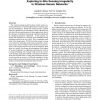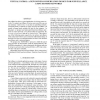21 search results - page 4 / 5 » Preserving Area Coverage in Wireless Sensor Networks by Usin... |
JUCS
2008
13 years 6 months ago
2008
: Wireless Sensor Networks (WSN) allow, thanks to the use of small wireless devices known as sensor nodes, the monitorization of wide and remote areas with precision and liveness u...
IJSNET
2006
13 years 6 months ago
2006
: In this paper, we present a two-tiered scheduling approach for effective energy conservation in wireless sensor networks. The effectiveness of this mechanism relies on dynamicall...
TPDS
2010
13 years 4 months ago
2010
The circular sensing model has been widely used to estimate performance of sensing applications in existing analysis and simulations. While this model provides valuable high-level...
IPSN
2005
Springer
13 years 11 months ago
2005
Springer
Surveillance has been a typical application of wireless sensor networks. To conduct surveillance of a given area in real life, one can use stationary watch towers, or can also use...
SENSYS
2004
ACM
13 years 11 months ago
2004
ACM
Monitoring of environmental phenomena with embedded networked sensing confronts the challenges of both unpredictable variability in the spatial distribution of phenomena, coupled ...


